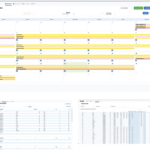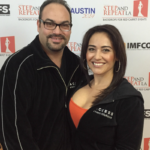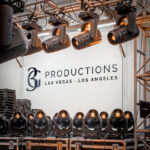 (In case you missed it, the Stratos project involved daredevil Felix Baumgartner going to the edge of space and jumping 120,000 feet to earth. Riedel provided communications for that project, integrating both wireless and wired digital intercom systems. Riedel also was there for the fiber-based video and signal distribution as well as the wireless video links from the capsule’s onboard cameras.)
(In case you missed it, the Stratos project involved daredevil Felix Baumgartner going to the edge of space and jumping 120,000 feet to earth. Riedel provided communications for that project, integrating both wireless and wired digital intercom systems. Riedel also was there for the fiber-based video and signal distribution as well as the wireless video links from the capsule’s onboard cameras.) Thomas Riedel, who started the company while still in high school, has built up a worldwide organization with 11 locations in Europe, Australia, Asia, and the Americas employing over 350 people. Today, they design, manufacturer, and distribute networks for video, audio, and communications for live events, from concerts to theaters to Formula 1 races to the Olympics. Despite all this, Riedel found time to sit down to talk to PLSN about the present, past, and future of communications for live events.
Thomas Riedel, who started the company while still in high school, has built up a worldwide organization with 11 locations in Europe, Australia, Asia, and the Americas employing over 350 people. Today, they design, manufacturer, and distribute networks for video, audio, and communications for live events, from concerts to theaters to Formula 1 races to the Olympics. Despite all this, Riedel found time to sit down to talk to PLSN about the present, past, and future of communications for live events.
PLSN: Congratulations on reaching the quarter of a century mark.
Thomas Riedel: It was really exciting. When I started Riedel Communications, I never dared to imagine that it might turn out this way. [The party] was a great night and a good opportunity to thank all of our clients and the Riedel team for the past 25 years and our shared success.
 Looking back, what’s a personal highlight that stands out you?
Looking back, what’s a personal highlight that stands out you?
There were a lot of great moments and big events in the past 25 years. One remarkable event for sure was our first Opening Ceremonies of the Olympic Winter Games 1994 in Lillehammer. That was an important milestone for the company and its development. One of the more recent events was definitely the Red Bull Stratos project.
 Talk about that project — how did that come about?
Talk about that project — how did that come about?
We have been working together with Red Bull on a number of projects, ranging from Red Bull Air Race to X-Fighters. They approached us at the start of this project. Because of our shared experience, we had a good understanding of working together and solving the project’s challenges.
 What was the biggest challenge?
What was the biggest challenge?
One of the biggest challenges was probably setting up a working remote mini OB system in the capsule, together with providing a reliable communications link during the jump.
 Did any new technology come out of that project that can be used on planet live event world?
Did any new technology come out of that project that can be used on planet live event world?
Besides our systems such as MediorNet, Artist, and radio communication, everything else was especially developed for this project. We don’t have plans on using this specifically on upcoming projects, but the knowledge gained at the Stratos project is definitely not wasted, and will find its ways into other projects in one or the other way, I’m sure.
 2012 was a big year in other ways — you opened a new office in Singapore. Has that been a good move for the company?
2012 was a big year in other ways — you opened a new office in Singapore. Has that been a good move for the company?
Absolutely. The Southeast Asian region is one of the most expanding markets in the world. The new office also allows us to provide a lot more detailed support and service, plus we now also offer a comprehensive rental operation providing communications and backbone infrastructure technology for video, audio and data.
 How is the business of communications in live events changing?
How is the business of communications in live events changing?
What we witness these days in live events is a big change to the infrastructure itself. Even just a couple of years ago, live events consisted of several individual infrastructures installed side by side. Nowadays these infrastructures are combined and streamlined into a single, integrated signal backbone that transport all of the relevant signals including video, audio, communications and data. I’m really confident that the next years will show an even more increased demand for such flexible systems.
 What’s Riedel’s biggest challenge going forward?
What’s Riedel’s biggest challenge going forward?
I think the biggest challenge for the market is making investments last. This is something we at Riedel strongly believe in. Return on investment and long-term approaches to infrastructure design are pivotal to our approach.
 That can be a challenging prospect — what are some recent products that reach that goal?
That can be a challenging prospect — what are some recent products that reach that goal?
Our new RockNet interface cards for integrating SSL and Soundcraft Compact Si consoles are quite interesting. So is our recently introduced MediorNet interface card for Grass Valley 3G based cameras that enables Grass Valley cameras and base stations to be directly connected to the MediorNet system, which leads to really flexible and remote production possibilities.
 From your workbench, what’s the next for Riedel in the next 25 years?
From your workbench, what’s the next for Riedel in the next 25 years?
I hope I will still be doing, what I do today. This market is so interesting in terms of constant change and innovation that I’m sure there will enough room for some really surprising developments. I can’t say what Riedel will look like in 25 years — probably a lot different. But one thing I know for sure — we will share the same excitement and commitment for the market as we do today, because this is what we enjoy: making productions easier and even more flexible.


